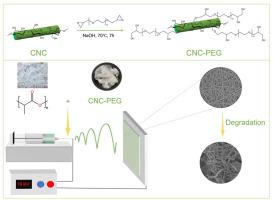Enhancement of mechanical and thermal properties of PLA electrospun films based on PEG-grafted cellulose nanocrystals
IF 7.7
2区 材料科学
Q1 MATERIALS SCIENCE, COMPOSITES
引用次数: 0
Abstract
Polylactic acid (PLA) is attracting attention as an alternative to petroleum-based plastics due to its environmentally friendly, biodegradable properties. However, PLA has limitations such as poor heat resistance, brittleness, and susceptibility to deformation at high temperatures, which leads to property deterioration. To address these issues, polyethylene glycol grafted cellulose nanocrystals (CNC-PEG) were successfully synthesized and composited with PLA through electrospinning. The morphology, hydrophilicity, permeability, thermal, and mechanical properties of the composite fiber films were characterized at CNC-PEG contents ranging from 0.5 % to 8 %. The incorporation of polyethylene glycol enhanced the compatibility between PLA and CNCs, while also improving the mechanical characteristics and thermal stability of the fiber film. At a CNC-PEG content of 4 %, the tensile strength and elongation at break of the PLA/CNC-PEG fiber film increased by factors of 2.8 and 1.9, respectively, while the onset degradation temperature (To) and maximum decomposition temperature (Tmax) increased by 12 and 18 °C. This simple and versatile approach demonstrates great potential for improving the mechanical properties and thermal stability of PLA-based materials, providing a promising strategy for developing advanced PLA blends.

聚乙二醇接枝纤维素纳米晶增强聚乳酸静电纺丝薄膜的力学和热性能
聚乳酸(PLA)因其环保、可生物降解的特性而成为石油基塑料的替代品。然而,PLA有局限性,例如耐热性差、脆性和在高温下易变形,这导致性能恶化。为了解决这些问题,成功地合成了聚乙二醇接枝纤维素纳米晶体(CNC-PEG),并通过静电纺丝与聚乳酸(PLA)复合。在CNC-PEG含量为0.5% ~ 8%的情况下,对复合纤维薄膜的形貌、亲水性、渗透性、热性能和力学性能进行了表征。聚乙二醇的掺入增强了PLA和cnc之间的相容性,同时也改善了纤维膜的机械特性和热稳定性。当CNC-PEG含量为4%时,PLA/CNC-PEG纤维膜的拉伸强度和断裂伸长率分别提高了2.8和1.9倍,起始降解温度(To)和最高分解温度(Tmax)分别提高了12℃和18℃。这种简单而通用的方法在改善PLA基材料的机械性能和热稳定性方面显示出巨大的潜力,为开发先进的PLA共混物提供了有前途的策略。
本文章由计算机程序翻译,如有差异,请以英文原文为准。
求助全文
约1分钟内获得全文
求助全文
来源期刊

Composites Communications
Materials Science-Ceramics and Composites
CiteScore
12.10
自引率
10.00%
发文量
340
审稿时长
36 days
期刊介绍:
Composites Communications (Compos. Commun.) is a peer-reviewed journal publishing short communications and letters on the latest advances in composites science and technology. With a rapid review and publication process, its goal is to disseminate new knowledge promptly within the composites community. The journal welcomes manuscripts presenting creative concepts and new findings in design, state-of-the-art approaches in processing, synthesis, characterization, and mechanics modeling. In addition to traditional fiber-/particulate-reinforced engineering composites, it encourages submissions on composites with exceptional physical, mechanical, and fracture properties, as well as those with unique functions and significant application potential. This includes biomimetic and bio-inspired composites for biomedical applications, functional nano-composites for thermal management and energy applications, and composites designed for extreme service environments.
 求助内容:
求助内容: 应助结果提醒方式:
应助结果提醒方式:


